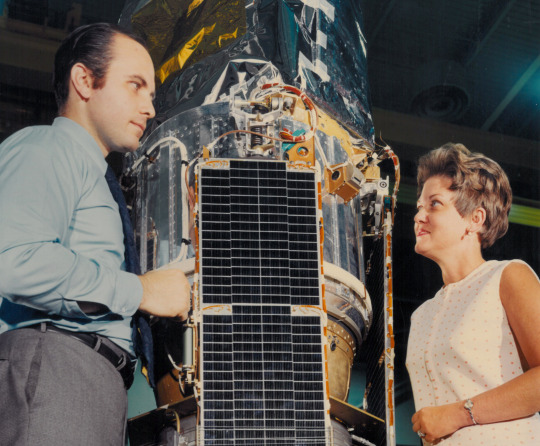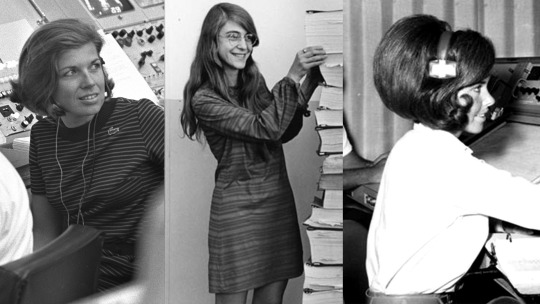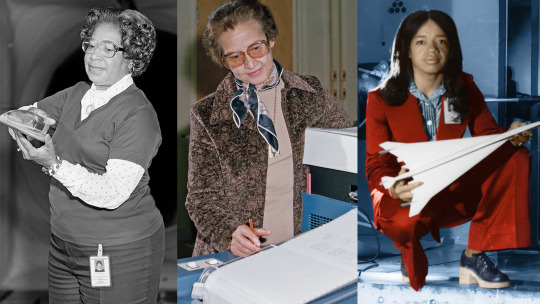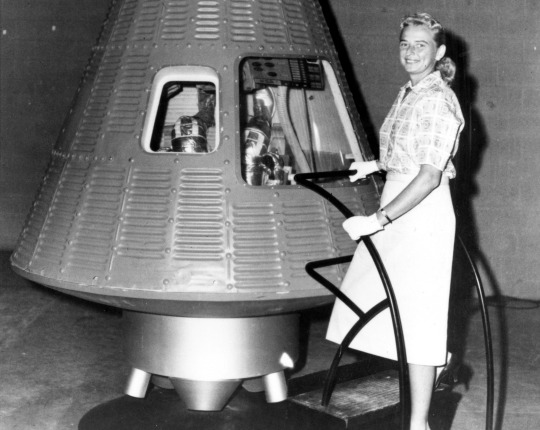#iac2019
Explore tagged Tumblr posts
Text
Women in Exploration: From Human Computers to All-Woman Spacewalks

Since the 19th century, women have been making strides in areas like coding, computing, programming and space travel, despite the challenges they have faced. Sally Ride joined NASA in 1983 and five years later she became the first female American astronaut. Ride's accomplishments paved the way for the dozens of other women who became astronauts, and the hundreds of thousands more who pursued careers in science and technology. Just last week, we celebrated our very first #AllWomanSpacewalk with astronauts Christina Koch and Jessica Meir.
Here are just a couple of examples of pioneers who brought us to where we are today:
The Conquest of the Sound Barrier

Pearl Young was hired in 1922 by the National Advisory Committee for Aeronautics (NACA), NASA’s predecessor organization, to work at its Langley site in support in instrumentation, as one of the first women hired by the new agency. Women were also involved with the NACA at the Muroc site in California (now Armstrong Flight Research Center) to support flight research on advanced, high-speed aircraft. These women worked on the X-1 project, which became the first airplane to fly faster than the speed of sound.
Young was the first woman hired as a technical employee and the second female physicist working for the federal government.
The Human Computers of Langley

The NACA hired five women in 1935 to form its first “computer pool”, because they were hardworking, “meticulous” and inexpensive. After the United States entered World War II, the NACA began actively recruiting similar types to meet the workload. These women did all the mathematical calculations – by hand – that desktop and mainframe computers do today.
Computers played a role in major projects ranging from World War II aircraft testing to transonic and supersonic flight research and the early space program. Women working as computers at Langley found that the job offered both challenges and opportunities. With limited options for promotion, computers had to prove that women could successfully do the work and then seek out their own opportunities for advancement.
Revolutionizing X-ray Astronomy

Marjorie Townsend was blazing trails from a very young age. She started college at age 15 and became the first woman to earn an engineering degree from the George Washington University when she graduated in 1951. At NASA, she became the first female spacecraft project manager, overseeing the development and 1970 launch of the UHURU satellite. The first satellite dedicated to x-ray astronomy, UHURU detected, surveyed and mapped celestial X-ray sources and gamma-ray emissions.
Women of Apollo
NASA’s mission to land a human on the Moon for the very first time took hundreds of thousands workers. These are some of the stories of the women who made our recent #Apollo50th anniversary possible:

• Margaret Hamilton led a NASA team of software engineers at the Massachusetts Institute of Technology and helped develop the flight software for NASA’s Apollo missions. She also coined the term “software engineering.” Her team’s groundbreaking work was perfect; there were no software glitches or bugs during the crewed Apollo missions.
• JoAnn Morgan was the only woman working in Mission Control when the Apollo 11 mission launched. She later accomplished many NASA “firsts” for women: NASA winner of a Sloan Fellowship, division chief, senior executive at the Kennedy Space Center and director of Safety and Mission Assurance at the agency.
• Judy Sullivan, was the first female engineer in the agency’s Spacecraft Operations organization, was the lead engineer for health and safety for Apollo 11, and the only woman helping Neil Armstrong suit up for flight.
Hidden Figures
Author Margot Lee Shetterly’s book – and subsequent movie – Hidden Figures, highlighted African-American women who provided instrumental support to the Apollo program, all behind the scenes.

• An alumna of the Langley computing pool, Mary Jackson was hired as the agency’s first African-American female engineer in 1958. She specialized in boundary layer effects on aerospace vehicles at supersonic speeds.
• An extraordinarily gifted student, Katherine Johnson skipped several grades and attended high school at age 13 on the campus of a historically black college. Johnson calculated trajectories, launch windows and emergency backup return paths for many flights, including Apollo 11.
• Christine Darden served as a “computress” for eight years until she approached her supervisor to ask why men, with the same educational background as her (a master of science in applied mathematics), were being hired as engineers. Impressed by her skills, her supervisor transferred her to the engineering section, where she was one of few female aerospace engineers at NASA Langley during that time.
Lovelace’s Woman in Space Program

Geraldyn “Jerrie” Cobb was the among dozens of women recruited in 1960 by Dr. William Randolph "Randy" Lovelace II to undergo the same physical testing regimen used to help select NASA’s first astronauts as part of his privately funded Woman in Space Program.
Ultimately, thirteen women passed the same physical examinations that the Lovelace Foundation had developed for NASA’s astronaut selection process. They were: Jerrie Cobb, Myrtle "K" Cagle, Jan Dietrich, Marion Dietrich, Wally Funk, Jean Hixson, Irene Leverton, Sarah Gorelick, Jane B. Hart, Rhea Hurrle, Jerri Sloan, Gene Nora Stumbough, and Bernice Trimble Steadman. Though they were never officially affiliated with NASA, the media gave these women the unofficial nicknames “Fellow Lady Astronaut Trainees” and the “Mercury Thirteen.”
The First Woman on the Moon

The early space program inspired a generation of scientists and engineers. Now, as we embark on our Artemis program to return humanity to the lunar surface by 2024, we have the opportunity to inspire a whole new generation. The prospect of sending the first woman to the Moon is an opportunity to influence the next age of women explorers and achievers.
This material was adapted from a paper written by Shanessa Jackson (Stellar Solutions, Inc.), Dr. Patricia Knezek (NASA), Mrs. Denise Silimon-Hill (Stellar Solutions), and Ms. Alexandra Cross (Stellar Solutions) and submitted to the 2019 International Astronautical Congress (IAC). For more information about IAC and how you can get involved, click here.
Make sure to follow us on Tumblr for your regular dose of space: http://nasa.tumblr.com
#womeninSTEM#WomenatNASA#WomenofNASA#space#NASA#universe#solar system#iac2019#Artemis#apollo 11#Apollo 50th#astronauts#allwomanspacewalk#womeninspace#aerospace#aerospace engineering#flight#spaceflight#Human spaceflight#stem#satellite#hidden figures
3K notes
·
View notes
Text
Also gotta say I’m loving Myles giving Roman a nickname already
22 notes
·
View notes
Video
instagram
Apollo 11 computer replica courtesy of @thebisofficial Italian chapter at #IAC2019 This thing worked and felt just like the original and the builder even made sure the buttons felt the same when pressed. Eva somehow messed something up but we hope a reboot took care of it. Going to make this! ◇◇ ◇◇ #iac2019dc #apollo #apollo11 #moonmission #space #britishinterplanetarysociety #bisitalia #nasa #lunarlander #lmcomputer #computer #spaceexploration @andystechgarage #atg #andystechgarage #stemandy #stemeva #andystem #evastem #stematg #atgstem https://www.instagram.com/p/B5kXMFrFVCL/?igshid=1gqvfbmlamvi7
#iac2019#iac2019dc#apollo#apollo11#moonmission#space#britishinterplanetarysociety#bisitalia#nasa#lunarlander#lmcomputer#computer#spaceexploration#atg#andystechgarage#stemandy#stemeva#andystem#evastem#stematg#atgstem
1 note
·
View note
Photo

From Astronautical Wear to Colonization & Residential facilities, the future is happening now! 🚀👽🤖🌌🌠 #washington #dc #washdc #washingtondc #districtofcolumbia #international #astronautical #congess #aiaa #iac2019 #iac @iafastro (at Walter E. Washington Convention Center) https://www.instagram.com/p/B4ALhXKHQ36/?igshid=4xill98storc
#washington#dc#washdc#washingtondc#districtofcolumbia#international#astronautical#congess#aiaa#iac2019#iac
0 notes
Text










It was a great experience attending the International Astronautical Congress 2019 in Washington DC. I was pleased to meet new faces, all space enthusiasts. This year I just attended IAC, but next year I'll be presenting in it.
#iac2019 #iafastro
#washingtondc #aiaa #lockheedmartin #nasa #esa #isro #spaceloveforever
#astrobiologist
0 notes
Video
youtube
IAC2019 JAXAブースの様子 https://youtu.be/EH7ITFyN7Vg
0 notes
Quote
Favorite tweets: 2020 marks @Space_Station's 20th year of habitation and our 27th year as its prime contractor. Station crews worked on treatments for medical conditions, proved technology for deep-space exploration and took measurements of our changing Earth. #IAC2019 pic.twitter.com/y3eSHaVGFp— Boeing Space (@BoeingSpace) October 23, 2019
http://twitter.com/BoeingSpace
0 notes
Text
RT @LucRiesbeck: The fun is just beginning! #IAC2019 https://t.co/FIN4MDzkER
The fun is just beginning! #IAC2019 pic.twitter.com/FIN4MDzkER
— dra-luc-a🧛🏼♀️🌙 (@LucRiesbeck) October 19, 2019
via Twitter https://twitter.com/marscoinorg October 20, 2019 at 12:28AM
0 notes
Text
SPACE: A Global Frontier
Space is a global frontier. That’s why we partner with nations all around the world to further the advancement of science and to push the boundaries of human exploration. With international collaboration, we have sent space telescopes to observe distant galaxies, established a sustainable, orbiting laboratory 254 miles above our planet’s surface and more! As we look forward to the next giant leaps in space exploration with our Artemis lunar exploration program, we will continue to go forth with international partnerships!
Teamwork makes the dream work. Here are a few of our notable collaborations:
Artemis Program

Our Artemis lunar exploration program will send the first woman and the next man to the Moon by 2024. Using innovative technologies and international partnerships, we will explore more of the lunar surface than ever before and establish sustainable missions by 2028.
youtube
During these missions, the Orion spacecraft will serve as the exploration vehicle that will carry the crew to space, provide emergency abort capability and provide safe re-entry from deep space return velocities. The European Service Module, provided by the European Space Agency, will serve as the spacecraft’s powerhouse and supply it with electricity, propulsion, thermal control, air and water in space.

The Gateway, a small spaceship that will orbit the Moon, will be a home base for astronauts to maintain frequent and sustainable crewed missions to the lunar surface. With the help of a coalition of nations, this new spaceship will be assembled in space and built within the next decade.
Gateway already has far-reaching international support, with 14 space agencies agreeing on its importance in expanding humanity's presence on the Moon, Mars and deeper into the solar system.
International Space Station

The International Space Station (ISS) is one of the most ambitious international collaborations ever attempted. Launched in 1998 and involving the U.S., Russia, Canada, Japan and the participating countries of the European Space Agency — the ISS has been the epitome of global cooperation for the benefit of humankind. The largest space station ever constructed, the orbital laboratory continues to bring together international flight crews, globally distributed launches, operations, training, engineering and the world’s scientific research community.
Hubble Space Telescope

The Hubble Space Telescope, one of our greatest windows into worlds light-years away, was built with contributions from the European Space Agency (ESA).

ESA provided the original Faint Object Camera and solar panels, and continues to provide science operations support for the telescope.
Deep Space Network

The Deep Space Network (DSN) is an international array of giant radio antennas that span the world, with stations in the United States, Australia and Spain. The three facilities are equidistant approximately one-third of the way around the world from one another – to permit constant communication with spacecraft as our planet rotates. The network supports interplanetary spacecraft missions and a few that orbit Earth. It also provides radar and radio astronomy observations that improve our understanding of the solar system and the larger universe!
Mars Missions
Information gathered today by robots on Mars will help get humans to the Red Planet in the not-too-distant future. Many of our Martian rovers – both past, present and future – are the products of a coalition of science teams distributed around the globe. Here are a few notable ones:
Curiosity Mars Rover

France: ChemCam, the rover’s laser instrument that can analyze rocks from more than 20 feet away
Russia: DAN, which looks for subsurface water and water locked in minerals
Spain: REMS, the rover’s weather station
InSight Mars Lander

France with contributions from Switzerland: SEIS, the first seismometer on the surface of another planet
Germany: HP3, the heatflow probe that will help us understand the interior structure of Mars
Spain: APSS, the lander’s weather station
Mars 2020 Rover

Norway: RIMFAX, a ground-penetrating radar
France: SuperCam, the laser instrument for remote science
Spain: MEDA, the rover’s weather station
Space-Analog Astronaut Training
We partner with space agencies around the globe on space-analog missions. Analog missions are field tests in locations that have physical similarities to the extreme space environments. They take astronauts to space-like environments to prepare as international teams for near-term and future exploration to asteroids, Mars and the Moon.

The European Space Agency hosts the Cooperative Adventure for Valuing and Exercising human behavior and performance Skills (CAVES) mission. The two week training prepares multicultural teams of astronauts to work safely and effectively in an environment where safety is critical. The mission is designed to foster skills such as communication, problem solving, decision-making and team dynamics.

We host our own analog mission, underwater! The NASA Extreme Environment Mission Operations (NEEMO) project sends international teams of astronauts, engineers and scientists to live in the world’s only undersea research station, Aquarius, for up to three weeks. Here, “aquanauts” as we call them, simulate living on a spacecraft and test spacewalk techniques for future space missions in hostile environments.
International Astronautical Congress
youtube
So, whether we’re collaborating as a science team around the globe, or shoulder-to-shoulder on a spacewalk, we are committed to working together with international partners for the benefit of all humanity!
If you’re interested in learning more about how the global space industry works together, check out our coverage of the 70th International Astronautical Congress (IAC) happening this week in Washington, D.C. IAC is a yearly gathering in which all space players meet to talk about the advancements and progress in exploration.
Make sure to follow us on Tumblr for your regular dose of space: http://nasa.tumblr.com
#NASA#space#science#Artemis#Hubble Space Telescope#Mars#solar system#exploration#planets#curiosity#curiosity rover#mars rover#multicultural#iac2019#International Space Station#ISS
1K notes
·
View notes
Text
Caitlyn is not phased is she. First of all she has James shouting at her during the pontoon task and she just talks about going to get a beer. Then she just sits in the car when everyone gets out screaming about the spider
4 notes
·
View notes
Video
instagram
This little guy has many siblings in space. #smallsat ◇◇ ◇◇ ◇◇ #smallsatellite #satellites #satellite #space #spaceexploration #IAC #technology #techinspace #IAC2019 #spacetechnology #spacetech @andystechgarage #atg #andystechgarage ©️ ⚠️DO NOT REPOST❗⚠️ https://www.instagram.com/p/CB76hwhj99n/?igshid=rzzvg3af0aio
#smallsat#smallsatellite#satellites#satellite#space#spaceexploration#iac#technology#techinspace#iac2019#spacetechnology#spacetech#atg#andystechgarage
0 notes
Photo

There are so many options for space travel, transport, and logistics. 🚀👽🤖🌌🌠 #washington #dc #washdc #washingtondc #districtofcolumbia #international #astronautical #congess #aiaa #iac2019 #iac @iafastro (at Walter E. Washington Convention Center) https://www.instagram.com/p/B3-qqz5nFq9/?igshid=187wpzbrp6jy8
#washington#dc#washdc#washingtondc#districtofcolumbia#international#astronautical#congess#aiaa#iac2019#iac
0 notes
Photo

This landing module titled Blue Moon. I can't wait for space tourism! 🚀👽🤖🌌🌠 #washington #dc #washdc #washingtondc #districtofcolumbia #international #astronautical #congess #aiaa #iac2019 #iac (at Walter E. Washington Convention Center) https://www.instagram.com/p/B39jwlPnnkO/?igshid=1gs5bbw9pe0gp
#washington#dc#washdc#washingtondc#districtofcolumbia#international#astronautical#congess#aiaa#iac2019#iac
0 notes
Photo

Today was a great day! Met new, interesting scientists from all over the globe. I was able to use my language skills (which were a little rusty). I can't wait for tomorrow! #washington #dc #washdc #washingtondc #districtofcolumbia #international #astronautical #congess #aiaa #iac2019 #iac (at Walter E. Washington Convention Center) https://www.instagram.com/p/B329LKsnZzW/?igshid=10wladd2ks88x
#washington#dc#washdc#washingtondc#districtofcolumbia#international#astronautical#congess#aiaa#iac2019#iac
0 notes
Photo

Attending the 70th International Astronautical Congress! I am so excited, I could really just punch myself in the throat! #washington #dc #washdc #washingtondc #districtofcolumbia #international #astronautical #congess #aiaa #iac2019 (at Walter E. Washington Convention Center) https://www.instagram.com/p/B3zvCriHEZ7/?igshid=95ga68q9ivky
#washington#dc#washdc#washingtondc#districtofcolumbia#international#astronautical#congess#aiaa#iac2019
0 notes